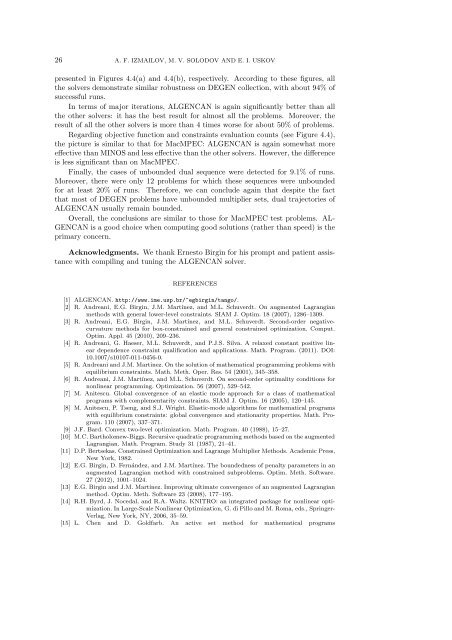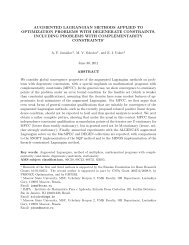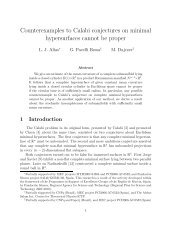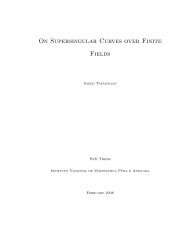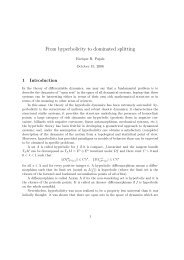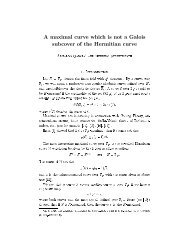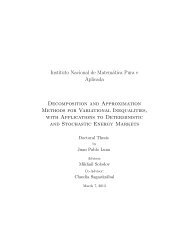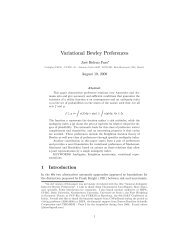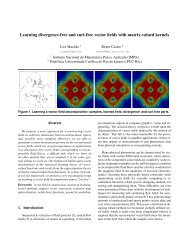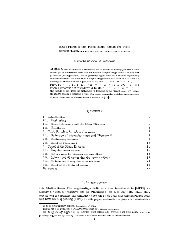Augmented Lagrangian methods applied to optimization problems ...
Augmented Lagrangian methods applied to optimization problems ...
Augmented Lagrangian methods applied to optimization problems ...
Create successful ePaper yourself
Turn your PDF publications into a flip-book with our unique Google optimized e-Paper software.
26 A. F. IZMAILOV, M. V. SOLODOV AND E. I. USKOV<br />
presented in Figures 4.4(a) and 4.4(b), respectively. According <strong>to</strong> these figures, all<br />
the solvers demonstrate similar robustness on DEGEN collection, with about 94% of<br />
successful runs.<br />
In terms of major iterations, ALGENCAN is again significantly better than all<br />
the other solvers: it has the best result for almost all the <strong>problems</strong>. Moreover, the<br />
result of all the other solvers is more than 4 times worse for about 50% of <strong>problems</strong>.<br />
Regarding objective function and constraints evaluation counts (see Figure 4.4),<br />
the picture is similar <strong>to</strong> that for MacMPEC: ALGENCAN is again somewhat more<br />
effectivethan MINOSand lesseffective thanthe othersolvers. However,the difference<br />
is less significant than on MacMPEC.<br />
Finally, the cases of unbounded dual sequence were detected for 9.1% of runs.<br />
Moreover, there were only 12 <strong>problems</strong> for which these sequences were unbounded<br />
for at least 20% of runs. Therefore, we can conclude again that despite the fact<br />
that most of DEGEN <strong>problems</strong> have unbounded multiplier sets, dual trajec<strong>to</strong>ries of<br />
ALGENCAN usually remain bounded.<br />
Overall, the conclusions are similar <strong>to</strong> those for MacMPEC test <strong>problems</strong>. AL-<br />
GENCAN is a good choice when computing good solutions (rather than speed) is the<br />
primary concern.<br />
Acknowledgments. We thank Ernes<strong>to</strong> Birgin for his prompt and patient assistance<br />
with compiling and tuning the ALGENCAN solver.<br />
REFERENCES<br />
[1] ALGENCAN. http://www.ime.usp.br/~egbirgin/tango/.<br />
[2] R. Andreani, E.G. Birgin, J.M. Martínez, and M.L. Schuverdt. On augmented <strong>Lagrangian</strong><br />
<strong>methods</strong> with general lower-level constraints. SIAM J. Optim. 18 (2007), 1286–1309.<br />
[3] R. Andreani, E.G. Birgin, J.M. Martínez, and M.L. Schuverdt. Second-order negativecurvature<br />
<strong>methods</strong> for box-constrained and general constrained <strong>optimization</strong>. Comput.<br />
Optim. Appl. 45 (2010), 209–236.<br />
[4] R. Andreani, G. Haeser, M.L. Schuverdt, and P.J.S. Silva. A relaxed constant positive linear<br />
dependence constraint qualification and applications. Math. Program. (2011). DOI:<br />
10.1007/s10107-011-0456-0.<br />
[5] R. Andreani and J.M. Martinez. On the solution of mathematical programming <strong>problems</strong> with<br />
equilibrium constraints. Math. Meth. Oper. Res. 54 (2001), 345–358.<br />
[6] R. Andreani, J.M. Martínez, and M.L. Schuverdt. On second-order optimality conditions for<br />
nonlinear programming. Optimization. 56 (2007), 529–542.<br />
[7] M. Anitescu. Global convergence of an elastic mode approach for a class of mathematical<br />
programs with complementarity constraints. SIAM J. Optim. 16 (2005), 120–145.<br />
[8] M. Anitescu, P. Tseng, and S.J. Wright. Elastic-mode algorithms for mathematical programs<br />
with equilibrium constraints: global convergence and stationarity properties. Math. Program.<br />
110 (2007), 337–371.<br />
[9] J.F. Bard. Convex two-level <strong>optimization</strong>. Math. Program. 40 (1988), 15–27.<br />
[10] M.C.Bartholomew-Biggs.Recursive quadratic programming<strong>methods</strong> based on the augmented<br />
<strong>Lagrangian</strong>. Math. Program. Study 31 (1987), 21–41.<br />
[11] D.P. Bertsekas. Constrained Optimization and Lagrange MultiplierMethods. Academic Press,<br />
New York, 1982.<br />
[12] E.G. Birgin, D. Fernández, and J.M. Martínez. The boundedness of penalty parameters in an<br />
augmented <strong>Lagrangian</strong> method with constrained sub<strong>problems</strong>. Optim. Meth. Software.<br />
27 (2012), 1001–1024.<br />
[13] E.G. Birgin and J.M. Martínez. Improving ultimate convergence of an augmented <strong>Lagrangian</strong><br />
method. Optim. Meth. Software 23 (2008), 177–195.<br />
[14] R.H. Byrd, J. Nocedal, and R.A. Waltz. KNITRO: an integrated package for nonlinear <strong>optimization</strong>.<br />
In Large-Scale Nonlinear Optimization, G. diPilloand M.Roma, eds., Springer-<br />
Verlag, New York, NY, 2006, 35–59.<br />
[15] L. Chen and D. Goldfarb. An active set method for mathematical programs


